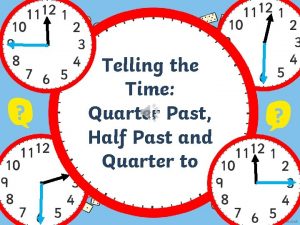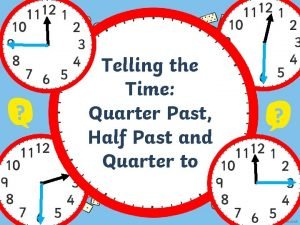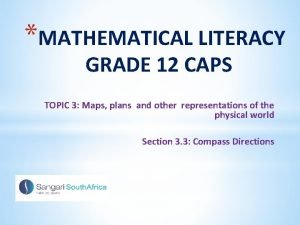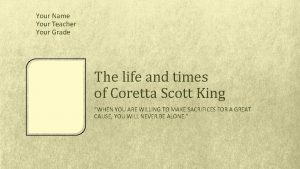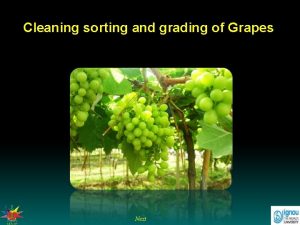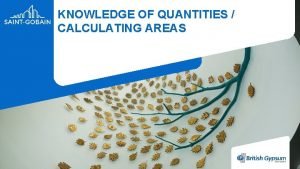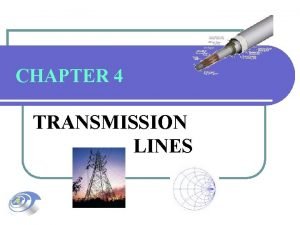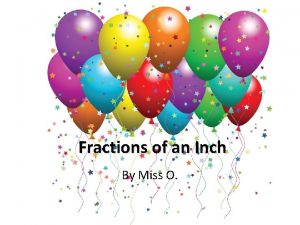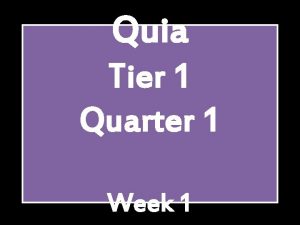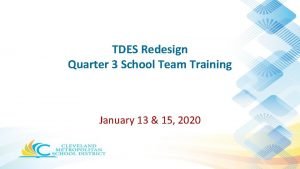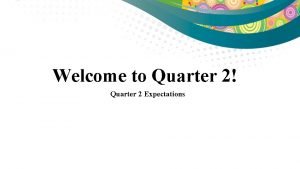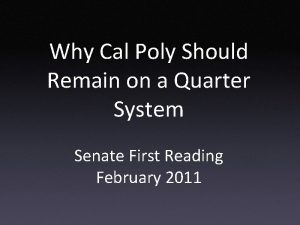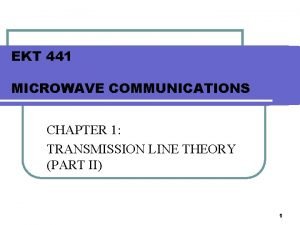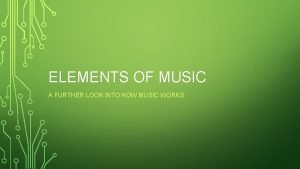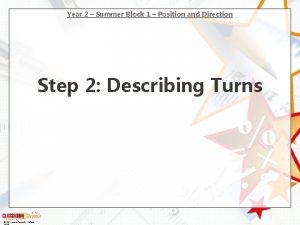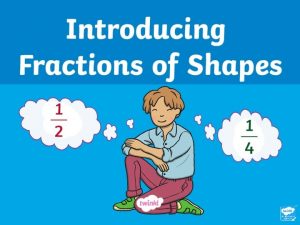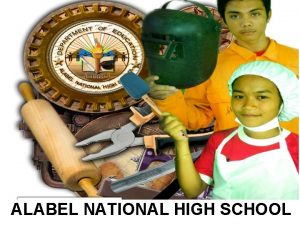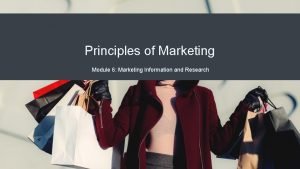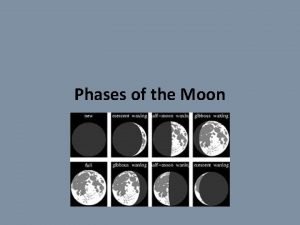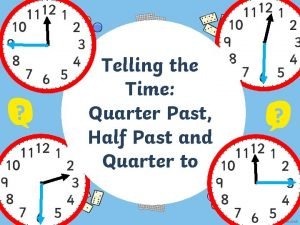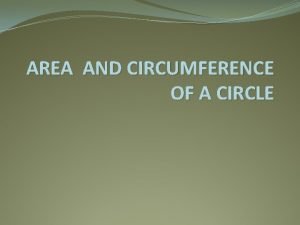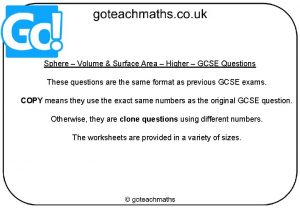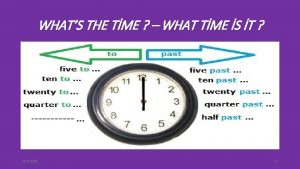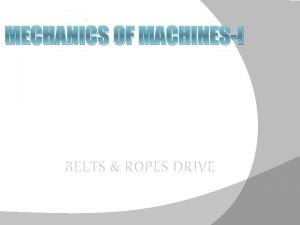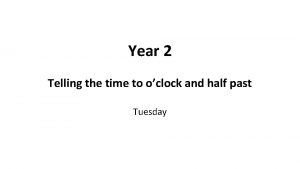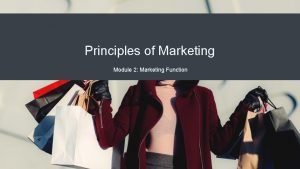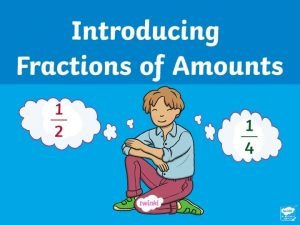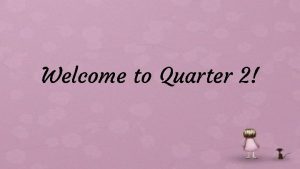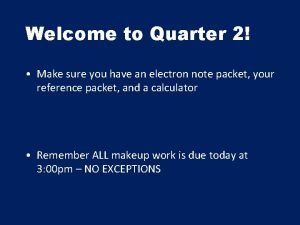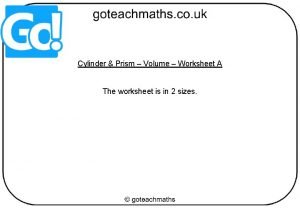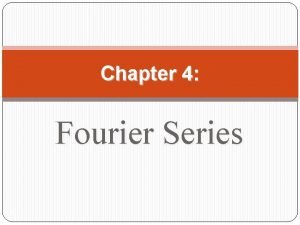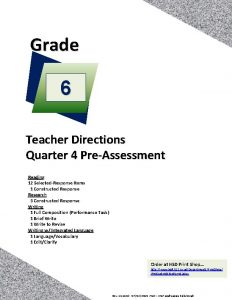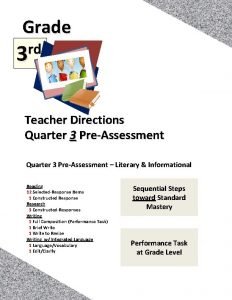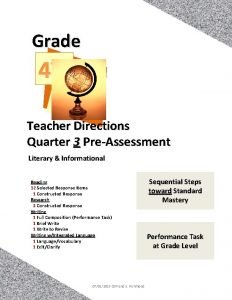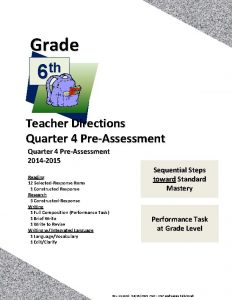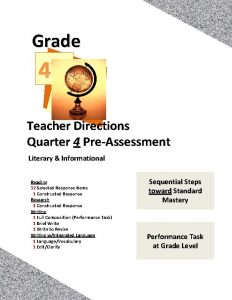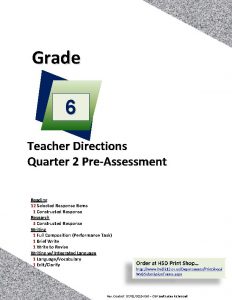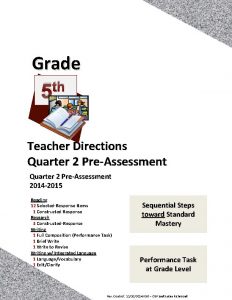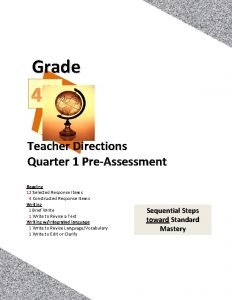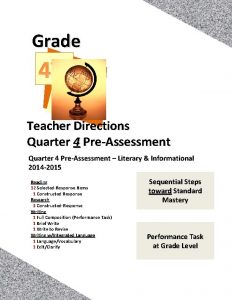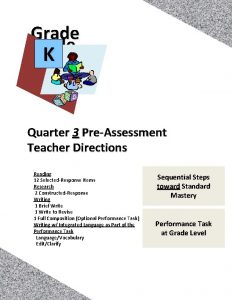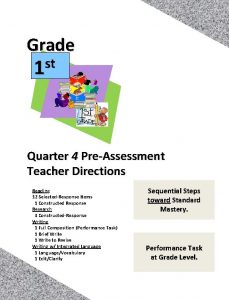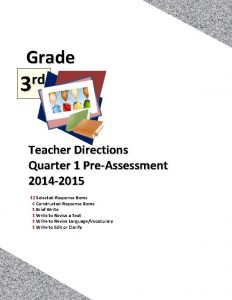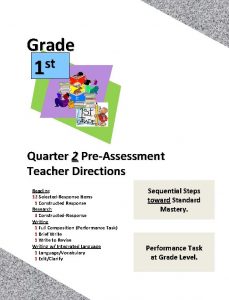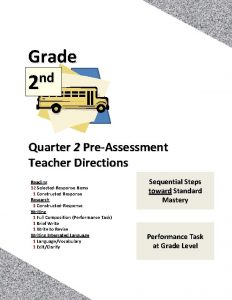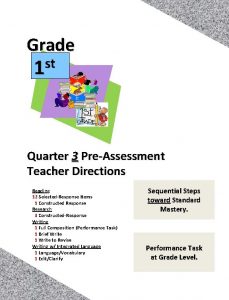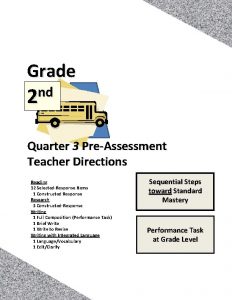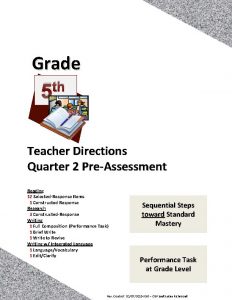Grade rd 3 Teacher Directions Quarter 4 PreAssessment











































- Slides: 43

Grade rd 3 Teacher Directions Quarter 4 Pre-Assessment 2014 -2015 Quarter 4 Pre-Assessment – Literary & Informational 2014 -2015 Reading 12 Selected-Response Items 1 Constructed Response Research 3 Constructed-Responses Writing 1 Full Composition (Performance Task) 1 Brief Write 1 Write to Revise Writing w/ Integrated Language 1 Language/Vocabulary 1 Edit/Clarify Sequential Steps toward Standard Mastery Performance Task at Grade Level

rd 3 Quarter Four 2014 -15 Pre-Assessment Reading: Literature Grade Four Targets Standards DOK 3 Reasoning and Evidence RL. 3 1 -2 6 Reasoning and Evidence RL. 6 2 5 Analysis Within and Across Texts RL. 9 4 Reading: Informational Grade Four Targets Standards DOK 10 Reasoning and Evidence RI. 3 1 -2 11 Reasoning and Evidence RI. 6 3 12 Analysis Within and Across Texts RI. 9 4 Note: There may be more standards per target. Only standards assessed are listed. Opinion Writing and Language Targets Standards DOK 1 a Brief Opinion Write W. 1 a, W. 1 b, W. 1 c, W. 1 d 3 1 b Write-Revise Opinion W. 1 a, W. 1 b, W. 1 c, W. 1 d 2 2 Full Opinion Composition W-1 a, W-1 b, W-1 c, W-1 d, W-4, W-5, W-8 4 8 Language-Vocabulary Use L. 3 a 1 -2 9 Edit and Clarify L. 3. 2 e 1 -2

This is a pre-assessment to measure the task of writing an opinion piece. Full compositions are always part of a Performance Task. A complete performance task would have: Part 1 • A Classroom Activity (30 Minutes) Activity should include 1. New language and vocabulary students may encounter in passages (taught through a source that does not pre-teach the actual passages). Vocabulary that may be new to students in the passages in this assessment may include: rainbow, frustrated, “top speed, ” valuable, serenity, gem, interrupted, passion, wisdom, respected, conversation, determined, indigo, philosophy, quarreling, symbol, rainstorm, slant, spectrum, waterfall, double, rare, spectacular, sunlight, arc, horizon, full-circle, upside-down, crystals, and moonshine. 2. A very simple explanation of what makes a rainbow (2 -3 rd grade but very effective): https: //www. youtube. com/watch? v=PXv. QEb 1 Mufg A more age appropriate explanation of what makes a rainbow: https: //www. youtube. com/watch? v=HUVuyt 3 FKi 0 3. (35 minutes – Independent work) • Passages or stimuli to Read • 3 Research Questions • There may be other constructed response questions. Part 2 • A Full-Composition (70 Minutes) Students should have access to spell-check resources but no grammar-check resources. Students can refer back to their passages, notes and 3 research questions and any other constructed responses, as often they’d like. The notetaking forms in this pre-assessment were created for informational text. If you choose to use these, please have your students take notes while reading the informational passages. Directions 30 minutes 1. You may wish to have a 30 minute classroom activity. The purpose of a PT activity is to ensure that all students are familiar with the concepts of the topic and know and understand key terms (vocabulary) that are at the upper end of their grade level (words they would not normally know or are unfamiliar to their background or culture). The classroom activity DOES NOT pre-teach any of the specific content that will be assessed! 35 minutes 2. Students read the passages independently. If you have students who can not read the passages you may read them to those students but please make note of the accommodation. Remind students to take notes as they read. During an actual SBAC assessment students are allowed to keep their notes as a reference. 3. Students answer the 3 research questions or other constructed response questions. Students should also refer to their answers when writing their full opinion piece. 15 minute break 70 Minutes 4. Students write their full composition (opinion piece). SCORING An opinion Rubric is provided. Students receive three scores: 1. Organization and Purpose 2. Evidence and Elaboration 3. Conventions Rev. Control: 04/20/2015 HSD – OSP and Susan Richmond 3

Order at HSD Print Shop… http: //www. hsd. k 12. or. us/Departments/Print. Shop/ Web. Submission. Forms. aspx Directions The HSD Elementary assessments are neither scripted nor timed assessments. They are a tool to inform instructional decision making. It is not the intent of these assessments to have students “guess and check” answers for the sake of finishing an assessment. All students should “move toward” taking the assessments independently but many will need scaffolding strategies. If students are not reading at grade level and can’t read the text, please read the stories to the students and ask the questions. Allow students to read the parts of the text that they can. Please note the level of differentiation a student needed. About this Assessment This assessment includes: Selected-Response, Constructed-Response, and a Performance Task. Types of SBAC Constructed Response Rubrics in this Assessment http: //www. livebinders. com/play? id=774846 Reading • 2 Point Short Response • 2 -3 Point Extended Response Writing • 4 Point Full Composition Rubric (Performance Task) • 2 -3 Point Brief Write (1 -2 Paragraphs) Rubric • 2 -3 Point Write to Revise Rubrics as Needed Research • 2 Point Rubrics Measuring Research Skill Use Quarter 4 Performance Task The underlined sections are those scored on SBAC. Please take 2 days to complete performance tasks. Part 1 • • Part 2 Classroom Activity if Desired/Needed Read two paired passages. Take notes while reading (note-taking). Answer SR and CR research questions about sources Components of Part 1 Note-Taking: Students take notes as they read passages to gather information about their sources. Students are allowed to use their notes to later write a full composition (essay). Note-taking strategies should be taught as structured lessons throughout the school year in grades K – 6. A teacher’s note-taking form with directions and a notetaking form for your students to use for this assessment is provided, or you may use whatever formats you’ve had past success with Please have students practice using the note-taking page in this document before the actual assessment if you choose to use it. Research: In Part 1 of a performance task students answer constructed response questions written to measure a student’s ability to use research skills needed to complete a performance task. These CR questions are scored using the SBAC Research Rubrics rather than reading response rubrics. • • Class Activity Plan your essay (brainstorming -pre-writing). Write, Revise and Edit (W. 5) Writing a Full Composition or Speech Components of Part 2 Planning Students review notes and sources and plan their composition. Write, Revise and Edit Students draft, write, revise and edit their writing. Word processing tools should be available for spell check (but no grammar check). This protocol focuses on the key elements of writing opinion pieces: 1. Statement of Purpose/Focus: Do you clearly state your opinion? Do you stay on topic? 2. Organization: Do your ideas flow logically from the introduction to conclusion? Do you use effective transitions? 3. Elaboration of Evidence: Do you provide evidence from sources about your opinions and elaborate with specific information? 4. Language and Vocabulary: Do you express your ideas effectively? Do you use precise language that is appropriate for your audience and purpose? 5. Conventions: Do you use punctuation, capitalization and spelling correctly? There are NO Technology-enhanced Items/Tasks (TE) Note: It is highly recommended that students have experiences with the following types of tasks from various on-line instructional practice sites, as they are not on the HSD Elementary Assessments: reordering text, selecting and changing text, selecting text, and selecting from drop-down menu Rev. Control: 04/20/2015 HSD – OSP and Susan Richmond

Pre-Assessment and Learning Progressions The pre-assessments measure progress toward standard proficiency Unlike the Common Formative Assessments which measure standard mastery, the pre-assessments are more like a base-line picture of a student’s strengths and gaps, measuring skills and concepts students need “along the way, ” in order to achieve standard mastery. Beg. of QTR CFA Example of a Learning Progression for RL. 2. 1 Pre-Assessments Measure Adjustment Points (in purple) RL. 2. 1 grade -level standard assessment. After the pre-assessment is given, Learning Progressions provide informal formative assessment below and near grade-level “tasks” throughout each. Throughout quarter. DOK 1 - Ka Recall who, what, where, when, why and how about a story read and discussed in class. DOK - Kc Use and define Standard Academic Language: who, what, where, when, why, and how; ask, answer, questions, key details DOK 1 - Cd Connect the terms who to characters; where and when to setting; what and how to sequence of events. DOK 1 - Cf Ask and answer who, what, where, when, why and how questions about key details in a text. the QTR DOK 2 - Ch Concept Development Student understands that key details help tell who, what, where, when, why and how. DOK 2 - Ck Uses key details to identify who, what, where, when, why and how about a story not read in class. END of QTR DOK 2 -Cl Finds information using key details to answer specific questions about a new story. Standard Mastery RL. 2. 1 Ask and answer such questions as who, what, where, when, why, and how to demonstrate understanding of key details in a text So what about a “post-assessment? ” There is not a standardized post-assessment. The true measure of how students are doing “along the way, ” is assessed in the classroom during instruction and classroom formative assessment. For this reason The CFA’s are not called “post-assessments. ” The CFAs measure the “end goal, ” or standard mastery. However, without the pre-assessments, how will we know what our instruction should focus on throughout each quarter? Learning Progressions: are the predicted set of skills needed to be able to complete the required task demand of each standard. The learning progressions were aligned to Hess’ Cognitive Rigor Matrix. The pre-assessments measure student proficiency indicated on the boxes in purple (adjustment points). These points are tasks that allow us to adjust instruction based on performance. For instance, if a student has difficulty on the first “purple” adjustment point (DOK-1, Cf) the teacher will need to go back to the tasks prior to DOK-1 Cf and scaffold instruction to close the gap, continually moving forward to the end of the learning progression. There is a Reading Learning Progression checklist for each standard in each grade that can be used to monitor progress. It is available at: http: //sresource. homestead. com/Grade-2. html Rev. Control: 04/20/2015 HSD – OSP and Susan Richmond 5

Quarter FOUR Reading Literature Learning Progressions. The indicated boxes highlighted before the standard, are assessed on this pre-assessment. The standard itself is assessed on the Common Formative Assessment (CFA) at the end of each quarter. DOK 1 - Ka Recall basic questions about characters and events in a story (read and discussed in class). DOK 1 - Kc Define standard academic language character, character traits (characteristic s, motivation, feelings, etc), events and sequence of time and “contributes to. . . ” DOK 1 - Ka Recall what specific characters in a text said about an event (read and discussed in class). DOK 1 - Ka Answers recall questions about themes, settings or plots from a book read and discussed in class. Not assessed DOK 1 - Cf Answer who, what, when, where and how questions about characters, Explain the traits, meaning of a motivations sequence of and feelings in events and give a story read an example. and discussed in class. DOK 1 - Cd Explain the meaning of character traits and give examples. DOK 1 - Kc Define (understand use) Standard Academic Language: point of view, distinguish, narrator, characters and phrase “from that of. . . ”. DOK 1 - Cd Identifies the narrator of a text. Identifies characters in a text. Not assessed DOK 2 - Ch DOK 2 - Cj Concept Make logical Developmen predictions t about how a character’s Explain how trait may characters’ influence an traits may action in a influence text, their actions supported with textual examples details. from a text. Not assessed DOK 1 - Cf Describe or explain specific parts of a text that give understanding to what a character or narrator said. Not assessed DOK 1 - Kc DOK 1 - Cf DOK 2 - Ch Cd Define Identify Answers Concept (understan the who, Development: d and use) literary what, Students Standard elements when, understand Academic in a text where or that a theme, Language: (theme, how setting and compare, setting questions plot in texts contrast, and plot) about written by theme, read and themes, same author setting, discusse setting may have plot, d in class. and plots similarities and similar, read and differences. characters discussed in class. DOK 2 - Ch Concept Development Understands that points of view vary and are reflected in words or actions and gives an example of own point of view. DOK 2 - ANq Identify use of literary devices used to describe character traits (i. e. , characterization, word usage, vivid descriptions). DOK 2 - ANq Identifies and compare the different points of view in a text. DOK 3 - Cu Explain a character’s point of view using supporting evidence from the text. DOK 3 - Cu Explain how a character’s actions contribute to a specific sequence of events using supporting evidence from the text (not discussed in class). DOK 3 - Cw Describe how a narrator’s or character’s point of view may affect the reader’s own point of view. DOK 2 - Cl DOK 2 - ANq DOK 3 - Cv DOK 3 - ANz Locate informatio n in two texts to show what themes, settings and plots have in common. SELECTED RESPONSE Classify literary elements of two or more texts (theme, setting and plot) written by the same author by similarities differences using a Venn. Identify themes across multiple texts written by the same author about the same or similar characters. Analyze how themes across multiple texts written by the same author are connected to each other. SELECTED RESPONSE DOK 3 - APx Outline a progression of character traits in a new text (one not read as a class or discussed) DOK 3 - ANA Analyze how a character or narrator’s point of view is different than your own. DOK 3 – SYH Synthesize informatio n about theme, setting or plot in one text and form a conclusion Standard RL 3. 3 Describe characters in a story (e. g. , their traits, motivations, or feelings) and explain how their actions contribute to the sequence of events Standard RL 3. 6 Distinguish their own point of view from that of the narrator or those of the characters. DOK 4 – SYU Synthesize information in two or more texts about theme, setting or plot using comparing and contrasting to form a conclusion. CONSTRUCTED REPSONSE Rev. Control: 04/20/2015 HSD – OSP and Susan Richmond Standard RL 3. 9 Compare and contrast themes, settings, and plots of stories written by the same author about the same or similar characters (e. g. , in books from a series). 6

Quarter FOUR Reading Informational Learning Progressions. The indicated boxes highlighted before the standard, are assessed on this pre-assessment. The standard itself is assessed on the Common Formative Assessment (CFA) at the end of each quarter. Path to DOK - 1 Grade 3 DOK Guide DOK 1 - Ka Path to DOK - 2 Not assessed DOK 1 - Kc End Goal Recall: specific Define transitional steps in a technical words pertaining to procedure time sequence and cause and effect such Path to DOK 2 Recall: a series of as; first, then, next, Informational historical events. after that, finally. Text Recall scientific Learning ideas or concept. Progressions. . . in text read/discussed. DOK 1 - Ka Recall what an author conveys in a text about an event (read and discussed in class). Describe how a series of events, ideas or concepts, or scientific steps are related when explaining Define (understand) the who, what, terms historical, when, where or scientific and technical how. as well as time, sequence and Not assessed in cause/effect. Quarter 4. DOK 1 - Kc Define (understand use) Standard Academic Language: point of view, distinguish, author, and phrase “from that of. . . ”. DOK 2 - Ch DOK 1 - Cf Describe or explain specific parts of a text that give understanding to an author’s point of view. DOK 2 - Cl Explain a cause and effect of Locate a historical event. information that explains a Explain the sequence of steps specific in a technical procedure. cause/effect or sequence about Explain time elements ideas, or between a series of historical concepts in a events. historical, scientific or Explain the influence of time procedural text. and cause/effect on scientific ideas or concepts. DOK 2 - Ch Concept Development Understands that an author’s point of view is reflected in words and gives an example of his/her own point of view. DOK 2 - ANq Identifies and lists the author’s points of views within a text. Compares an author’s point of view with their own. DOK 2 - ANp Classify ideas or concepts from two texts in order to locate the most important points. DOK 3 - Cu Explain an author’s point of view using supporting evidence from the text. DOK 3 - Cw Describe how an author’s point of view may affect the reader’s own point of view. Standard RI 3. 3 Describe the relationship between a series of historical events, scientific ideas or concepts, or steps in technical procedures in a text, using language that pertains to time, sequence, and cause/effect DOK 3 - ANA Analyze how an author’s point of view is different than your own. Standard RI 3. 6 Distinguish their own point of view from that of the author of a text. Not assessed DOK 1 - Ka DOK 1 - Kc Read and Define Discussed in Class: (understand Locate key details and use) in two texts on the Standard same topic. Academic Locate important Language: points in texts Compare, on the same topic. contrast, important points, key details, presented and topic. DOK 1 - Cf DOK 2 - Ch Answers who, what, where, when or how questions about key details, from two texts on the same topic. Concept development: Students understand that key details and important points can be found in two texts on the same topic. DOK 2 - Cl DOK 2 - ANp DOK 3 - Cu DOK 3 - ANy DOK 4 - SYU Standard Locate Categorize or Explain the Compare and Synthesize key RI 3. 9 Compare and important list key connection contrast details contrast the most points in two details from between similarities and presented in two important points texts on the two texts on differences of texts about the and key details same topic the same key details about same topic, presented in two (these are major topic under topic using important points correlating the texts on the same points or main important supporting in two texts on most important topic. ideas points or evidence the same topic. points into one supporting the main ideas. (key details). conclusion. topic). SELECTED CONSTRUCTED SELECTED REPONSE RESPONSE Rev. Control: 04/20/2015 HSD – OSP and Susan Richmond 7

Grade 3 R E- read S E SOMETHING NEW A EXPLAIN MORE Key Idea Write one new key idea about the main idea AGAIN and AGAIN R RELEVANT OR NOT? C CONCLUDE H HAVE EVIDENCE Instruct students to re-read a paragraph or section of the text they liked or you’ve chosen. Ask, “Does the section or paragraph state something new about the main idea? ” ______________________________________ idea This is a key idea about the main idea (be sure students know what the main idea is). ______________________________________ Have students write ONE brief sentence about the new key idea. Key Details 1 Explain more about the new key idea. Write two key details from the section or paragraph that support the key idea. Ask students to look for key details that explain more about • Key Detail _________________________________ the new key idea Key details are reasons that support a key idea. _____________________________________ idea Instruct Remember students to write 2 brief key details that support the key idea. will need to have a Example: If the main idea is about dogs and. . • Key Detail _________________________________ 2 note-taking form for “The dog likes to play, ” (is the key Idea), Idea each_____________________________________ passage. Then some key details might be: • the dog likes to play fetch. • the dog likes to play with the ball. Again and Again What words or phrases does the author use again and again? Write them here. Think about why the author them again and again. Have students keeps re-read using the paragraph or section they wrote about and write words or ideas they see Again and Again, Again in the box. 3 Explain, “When authors use the same words, phrases or ideas Again and Again ask yourself “why? ”. It means something is important. ” Instruct students to look at the again and again words or phrases, ask “Do you see some of the again and again words or ideas in the key ideas or key details sentences you wrote? Can the words help you write one conclusion sentence that tell the most about the key idea you chose? ” 4 Summarizing is a big part of writing conclusions. It is an extremely important strategy for students to learn in order to use research skills effectively. Write one conclusion sentence that tells the most about the new key idea and key details. Differentiation: Students who need more words pages – print as many Use some of the again and again if you can. as needed. Students who would benefit from enrichment can continue on with more sections or paragraphs. Students who need more direct instruction – teach part as a ______________________________________ mini lesson. These concepts can be taught separately: • Main Topic • Key Idea _______________________________________ • Key Details • Again and Again • Conclusions - Summarizing ELL Students may need each part taught using language (sentence) frames emphasizing transitional words. Rev. Control: 04/20/2015 HSD – OSP and Susan Richmond 8

Grade 3 R Eread S E SOMETHING NEW EXPLAIN MORE A AGAIN and AGAIN R RELEVANT OR NOT? C CONCLUDE H HAVE EVIDENCE Name_________ Passage________ Main Idea ______ Key Idea Write one new key idea about the main idea ____________________________________________________________________________ Key Details Explain more about the new key idea. Write two key details from the paragraph or section that support the new key idea. • Key Detail __________________________________________________________________________ • Key Detail _________________________________________________________________________ Again and Again What words or phrases does the author use again and again? Write them here. Think about why the author keeps using them again and again. Write one conclusion sentence that tells the most about the new key idea and key details. Use some of the again and again words if you can. ____________________________________________________________________________ Rev. Control: 04/20/2015 HSD – OSP and Susan Richmond 9

Listening & reading Productive modalities*: Ways in which students communicate to others (e. g. , speaking, writing, and drawing). Instruction and assessment of productive modalities focus on students’ communication of their own understanding or Speaking & Writing interpretation. Interactive modalities*: Collaborative use of receptive and productive modalities as “students engage in conversations, provide and obtain information, express feelings and emotions, and exchange opinions” (Phillips, 2008, p. 3). Standard 4 Productive (S & W) An ELL can… Listening, speaking, reading, and writing 10 - make accurate use of standard English to communicate in grade-appropriate speech and writing Receptive modalities*: Ways in which students receive communications from others (e. g. , listening, reading, viewing). Instruction and assessment of receptive modalities focus on students’ communication of their understanding of the meaning of communications from others. 9 - create clear and coherent grade-appropriate speech and text ELP 2 nd – 3 rd Grade Band Standards Organized by Modality 1 construct meaning from oral presentations and literary and informational text through grade-appropriate listening, reading, and viewing 8 determine the meaning of words and phrases in oral presentations and literary and informational text 3 speak and write about grade-appropriate complex literary and informational texts and topics 4 construct grade-appropriate oral and written claims and support them with reasoning and evidence 7 adapt language choices to purpose, task, and audience when speaking and writing 2 participate in grade-appropriate oral and written exchanges of information, ideas, and analyses, responding to peer, audience, or reader comments and questions 5 conduct research and evaluate and communicate findings to answer questions or solve problems 6 analyze and critique the arguments of others orally and in writing By the end of an English language proficiency level, an ELL in 2 nd – 3 rd Grade can. . . 1 …construct grade…express an appropriate oral opinion about a and written claims familiar topic. and support them with reasoning and evidence. 2 3 4 …express an opinion about a familiar topic or story, giving one or more reasons for the opinion. …express opinions about a variety of topics, introducing the topic & giving several reasons for the opinion. 5 …express opinions about a variety of topics, introducing the topic, giving several reasons for the opinion, & providing a concluding statement. This performance task is based on writing. As an option if you’d like to monitor growth for ELP as a second goal, teachers can choose to assess ELP standard 4 because it aligns with this specific performance task. Your student’s full composition can be analyzed to identify English language proficiency levels. It is evident that students will be navigating through the modalities to get to the end product. However, it is important to keep in mind what the full opinion writing performance task is assessing and how deeply the student understands class content and language. The ELP growth goal is to provide the “just-right scaffolds” for students to demonstrate their understanding in order for them to move from one proficiency level to the next. Oregon ELP Standards Aligned with Performance Task, 2014; Arcema Tovar

Opinion Writing Pre-Assessment Student and Class Scoring: Scoring Key: Total # Correct 1 = Emerging 0 -4 2 = Developing 3 = Proficient 4 = Exemplary 5 -7 8 - 10 School Year: 2014 -15 Grade: Teachers Name: School: 11 - 12 Focus and Organization Student Name: Score Elaboration and Conventions Evidence Score Student Total Score 1. 2. 3. 4. 5 0 6 0 7 0 8 0 9 0 10 0 11 0 12 0 13 0 14 0 15 0 16 0 17 0 18 0 19 0 20 0 21 0 22 0 23 0 24 0 25 0 26 0 27 0 28 0 29 0 30 0 31 0 32 0 33 0 34 0 35 4 Total Students 0 To use the Excel Version of this Score sheet. http: //sresource. homestead. com/index. html % Proficient % Exemplary 25% 75% 25% 50% 50% ELP Score

Grades 3 - 5: Generic 4 -Point Opinion Writing Rubric Score Statement of Purpose/Focus and Organization Statement of Purpose/Focus The response is fully sustained and consistently and purposefully focused: 4 Exemplary • opinion is clearly stated, focused, and strongly maintained • opinion is communicated clearly within the context The response is adequately sustained and generally focused: • opinion is clear 3 Proficient and for the most part maintained, though some loosely related material may be present • context provided for the claim is adequate The response is somewhat sustained with some extraneous material or a minor drift in focus: 2 Developing 1 Merging • may be clearly focused on the opinion but is insufficiently sustained • opinion on the issue may be unclear and unfocused The response may be related to the purpose but may offer little or no focus: • may be very brief • may have a major drift • opinion may be confusing or ambiguous 0 Organization Development: Language and Elaboration of Evidence The response has a clear and effective organizational structure creating unity and completeness: The response provides thorough and convincing support/evidence for the writer’s opinion that • effective, consistent use of a includes the effective use variety of transitional strategies of sources, facts, and • logical progression of ideas details: from beginning to end • effective introduction and conclusion for audience and purpose The response has an recognizable organizational structure, though there may be minor flaws and some ideas may be loosely connected: • adequate use of transitional strategies with some variety • adequate progression of ideas from beginning to end • adequate introduction and conclusion The response has an inconsistent organizational structure, and flaws are evident: • inconsistent use of transitional strategies with little variety • uneven progression of ideas from beginning to end • conclusion and introduction, if present, are weak The response has little or no discernible organizational structure: • use of evidence from sources is smoothly integrated, comprehensive, and relevant • effective use of a variety of elaborative techniques The response provides adequate support/evidence for the writer’s opinion that includes the use of sources, facts, and details: • some evidence from sources is integrated, though citations may be general or imprecise • adequate use of some elaborative techniques The response provides uneven, cursory support/evidence for the writer’s opinion that includes partial or uneven use of sources, facts, and details: • evidence from sources is Conventions The response clearly and effectively expresses ideas, using precise language: • use of academic and domain-specific vocabulary is clearly appropriate for the audience and purpose The response demonstrates a strong command of conventions: The response adequately expresses ideas, employing a mix of precise with more general language: The response demonstrates an adequate command of conventions: • use of domain-specific vocabulary is generally appropriate for the audience and purpose • few, if any, errors in usage and sentence formation e • effective and consistent use of punctuation, capitalization, and spelling • some errors in usage and sentence formation are present, but no systematic pattern of errors is displayed • adequate use of punctuation, capitalization, and spelling The response expresses The response ideas unevenly, using expresses ideas simplistic language: unevenly, using • use of domain-specific simplistic language: vocabulary that may at times be inappropriate for the audience and purpose weakly integrated, and citations, if present, are uneven • weak or uneven use of elaborative techniques The response provides minimal support/evidence for the writer’s opinion • few or no transitional strategies that includes little or no are evident use of sources, facts, and • frequent extraneous ideas may details: intrude Language and Vocabulary The response expression of ideas is vague, lacks clarity, or is confusing: • uses limited language or domain-specific vocabulary • use of evidence from sources is minimal, absent, • may have little sense of audience and purpose in error, or irrelevant • use of domain-specific vocabulary that may at times be inappropriate for the audience and purpose The response demonstrates a lack of command of conventions: • errors are frequent and severe and meaning is often obscured A response gets no credit if it provides no evidence of the ability to [fill in with key language from the intended target]. Working Drafts of ELA rubrics for assessing CCSS writing standards --- © (2010) Karin Hess, National Center for Assessment [khess@nciea. org Rev. Control: 04/20/2015 HSD – OSP and Susan Richmond 12

Quarter 4 Pre-Assessment Research Constructed Response Answer Key Constructed Response Research Rubrics Target 3 Evidence of the ability to distinguish relevant from irrelevant information such as fact from opinion. Question #7 RL. 3. 6 Prompt: What is your point of view about how the colors in The Whys of Weather- The Colors of the Rainbow acted? Is your point of view the same or different than the narrator’s? Explain your answer using details and examples from the text. Teacher /Rubric “Language Response” The response: gives sufficient evidence of the ability to distinguish relevant from irrelevant information about the prompt. First, students must be able to distinguish which relevant information from the text reflects and supports their point of view about how the colors acted. Details or examples from the text that support the student’s point of view about how the colors acted can be many and varied any are acceptable if supported with logic and from the text. However; some examples that could reflect the student’s point of view could include (1) a reference to the fact that the colors argued, (2) and references to the thing the colors said to one another while arguing. Secondly, students must determine if their point of view is the same or different than the narrator’s point of view, using details and examples from the text. Some examples could include (1) how the rain reacted to the arguing as supportive of the narrator’s point of view and (2) the outcome of the arguing. Student “Language” Response Example Student states his or her own point of view about how the colors acted in the story and states if their own point of view is similar or different than the narrator’s point of view. Student uses sufficient examples from the text. 2 1 0 In the story The Why of Weather – The Colors of the Rainbow, the characters are the colors of the rainbow. The colors argued about who is best and why. My point of view about the characters are that they should not argue and they should each appreciate each others’ differences. I feel this is also the point the narrator who is telling the story has based on how the story ends. After much arguing the narrator (I think the narrator is Rain), tells the colors to hold hands or make peace and get along because they are all special and the world would be sad without even one of them. To get the colors attention Rain makes lightning crash from the sky. When the colors huddle together I think of them as forming a rainbow. Student states his or her own point of view about how the colors acted in the story and partially or minimally states if their own point of view is similar or different than the narrator’s point of view. Student uses few examples from the text. People should not argue about who is better than someone else just like the colors should not argue or be jealous. That is my opinion about the colors. They are always arguing. Red thinks he’s better than blue and Indigo thinks he’s the best. They all have their reasons. The author thinks so too. Student does not state his or her own point of view about how the colors acted in the story or compare it to the narrator’s. Examples from the text are not used. Sometimes people just argue. That’s just the way it is. One time I had a fight with my best friend, but we made up. Toward RL. 3. 6 DOK 3 - ANA Analyze how a character or narrator’s point of view is different than your own. Rev. Control: 04/20/2015 HSD – OSP and Susan Richmond 13

Quarter 4 Pre-Assessment Constructed Response Answer Key Standard RL. 3. 9 3 Point Reading Constructed Response Rubric Question #8 (prompt): How are themes of Arcy’s Rainbow and The Whys of Weather- The Colors of the Rainbow similar? How are they different? Directions for Scoring: Write an overview of what students could include in a proficient response with examples from the text. Be very specific and “lengthy. ” Sufficient Evidence for a student response would include several components because this question is a DOK-4. A student response should: (1) identify or state what theme of each text is (2) compare the two themes for similarities (3) explain the major differences between both texts Full Support (other details) should support each of the three statements of evidence (listed above). Examples of each could include the following: (1) Identify or state what theme of each text is: The theme of the text for Arcy’s Rainbow, is how a girl finds out not only about rainbows but that sometimes you need to listen to others and you can learn more. The Why’s of Weather – The Colors of the Rainbow is that arguing and being jealous does not benefit anyone and that getting along does. (2) Compare the two themes for similarities: The two themes can be compared (meaning similarities) because they are (1) both fictional and both approach telling about rainbows and (2) both teach a lesson. (3) Explain the major differences between both texts: A response should explain that the major differences between the two texts are (1) one is written realistically while one is a fable that could not have happened, (2) the lessons learned are very different. The response states theme of both texts and provides proficient evidence of their similarities and major differences between each. 3 2 1 0 Both stories Arcy’s Rainbow and The Whys of Weather – The Colors of the Rainbow have a theme of learning a lesson by listening to others. What makes themes different is that the lessons learned are different. In Arcy’s Rainbow the girl learns that you can’t really catch a rainbow. Arcy also learns that rainbows are made by rain shining through the sun. In The Whys of Weather – The Colors of the Rainbow, the colors learn that arguing does not make peace or give hope. The colors also learn that when they join together they make a beautiful rainbow in the sky. The response partially states theme of both texts and provides partial evidence of their similarities and partial or some differences between the two texts with some evidence from the text. Both of the stories are about rainbows and rain. They both learn something important. The colors learn to quit arguing and the girl learns you can’t catch a rainbow. The response minimally states theme of both texts and provides minimal evidence of their similarities and minimal or vague differences between the two texts with little evidence from the text. These two stories are about what makes a rainbow. I love rainbows. That’s how they are similar. They are different too because sometimes you can’t see a rainbow and sometimes you can. The response does not clearly state theme of both texts or provides evidence of similarities. A rainbow is very beautiful and has many colors. The people in the story all loved rainbows too. Toward RL. 3. 9 DOK 4 – SYU Synthesize information in two or more texts about theme, setting or plot using comparing and contrasting to form a conclusion. 14 Rev. Control: 04/20/2015 HSD – OSP and Susan Richmond

Quarter 4 Pre-Assessment Research Constructed Response Answer Key Constructed Response Research Rubrics Target 3 Evidence of the ability to distinguish relevant from irrelevant information such as fact from opinion. Question #15 RL. 3. 6 Prompt: What is the author’s purposes for writing Rainbow Questions? Would you have changed or added anything differently? Explain your thinking using examples from the text. Teacher /Rubric “Language Response” The response gives sufficient evidence of the ability to distinguish relevant from irrelevant information (or… such as fact from opinion) about the prompt. Students must determine information that is relevant to their opinion as to why the author wrote the article. Students should first determine or state why the author wrote the article. The author’s purpose in writing this article was to answer questions people may have about rainbows. Students should state this in similar words or intent. Relevant evidence to support this could include: (1) the title of the article “Rainbow Questions, ” (2) each paragraph begins with a question, (3) the author answers the question stated in each paragraph and (4) any examples or details from the text used as supporting evidence as to why the author probably wrote the second article. Secondly, students should interject their own point of view (or purpose) by stating if they would have changed or added anything differently to the article, using examples from the text, and explaining why. Any statement is acceptable if it is supported explicitly by the text and logically follows the topic of the text. Student “Language” Response Example Student states why the author wrote the article and if he or she would have changed or added anything differently, logically explaining their point of view using sufficient examples from the text. 2 1 0 The author wrote Rainbow Questions to answer questions people may have about rainbows. Each section of the article begins with a question and ends with an answer. For instance, when asked Where do you look for a rainbow? The author explains that it must be raining and the sun shining! I would not have changed any of the information already in the article because it is important that each question be answered. I feel the author did a good job of answering each question. I would add real life examples of kids experiencing seeing the different kinds of rainbows and how they felt when they saw them. For instance the question that asks “Can a rainbow appear during the night? ” explains that it is rare to see a rainbow at night. Imagine having a kid tell about actually seeing one! The article has neat illustrations but real kids would make this even more interesting. Student states why the author wrote the article and if he or she would have changed or added anything differently, however the student minimally explains their point of view with few or no examples from the text. I really like the article Rainbow Questions because I learned a lot about different kinds of rainbows. There are upside-down rainbows and moonbows. These are really cool. I like how the author talks about these and the pictures too. I agree with the author and like it all. I wouldn’t change anything. Student does not logically state why the author wrote the article and does not specify if he or she would have changed or added anything differently. I like this story about different kinds of rainbows. I like all of them. I learned a lot about rainbows. Toward RI. 3. 6 DOK 3 - ANA Analyze how an author’s point of view is different than your own. Rev. Control: 04/20/2015 HSD – OSP and Susan Richmond 15

Quarter 4 Pre-Assessment Research Constructed Response Answer Key Constructed Response Research Rubrics Target 3 evidence of the ability to distinguish relevant from irrelevant information such as fact from opinion Question #16 RI. 3. 9 Prompt: Why do some rainbows look different than others? Give examples of different kinds of rainbows from both articles to explain your answer. Teacher /Rubric “Language Response” The response gives sufficient evidence of the ability to distinguish relevant from irrelevant information (or… such as fact from opinion) about the prompt. Students must locate and then select the information from both articles in order to answer the prompt. Students locate the different kinds of rainbows and then select information about each type in Order to describe their differences. The response: gives sufficient evidence of the ability to interpret and integrate information about the prompt. Students interpret information when analyzing differences and integrate information when summarizing why different kinds of rainbows look different. Student Responses that indicate the processes mentioned above could include: (1) listing rainbows that are different (e. g. , double rainbows, moonbows, upside down rainbows), (2) describing their differences (e. g. , double rainbows are two rainbows side by side, moonbows occur at night and are white, upside down rainbows looks like a smile), and (3) explaining what causes the differences or variations of each (making them look different). Examples of causes of variations could include: (1) Double rainbows look different because the sunlight reflects two times inside the water. The colors at the top are opposite from those at the bottom, (2) moonbows are caused by moonlight (not sunlight) shining through drops of water. This makes the moonbow look white, (3) upside down rainbows are caused by sunlight shining through ice crystals high in the sky. This makes it look like a smile. Any answers supported by facts from the articles are acceptable, but there should be examples from both articles. Student “Language” Response Example 2 Student gives examples of two different types of “rainbows, ” and explains why each looks different. Student uses many details from both texts. Not all rainbows look the same. Some even have different names. Rainbows can look different because they are created in different ways. When I think about rainbows I think about the ones you usually see that look like an arc with many colors. But not all look like this. These rainbows are made when sunlight passes through raindrops. But did you know that some rainbows look like twins? They are called double rainbows. When the sunlight reflects two times inside the raindrops it forms two rainbows. Even their colors are different. One has colors that are upside down from the other! There also rainbows called moonbows. Moonbows don’t look like regular rainbows either. At night if the moonshine slants just right through the rain, it makes a moonbow. They are very rare and look bright white! These are two examples of how rainbows can look different and why. 1 Student gives examples of 3 different kinds of rainbows but does not explain why each look different. There are many kinds of rainbows. Most rainbows look like the kind we see in the sky all the time. Some rainbows look different. Different kinds of rainbows are called moonbows, upside down rainbows and double rainbows. They all look different from each other. 0 Student presents no evidence to distinguish relevant from irrelevant information about the prompt. I have only seen one kind of rainbow. It has six colors in it. Toward RI. 3. 9 DOK-4 Synthesize key details presented in two texts about the same topic, correlating the most important points into one conclusion. Rev. Control: 04/20/2015 HSD – OSP and Susan Richmond 16

Note: “Brief Writes” should take no longer than 10 minutes. Brief writes are scored with a 2 -3 point rubric. Full compositions are scored with a 4 point rubric. The difference between this rubric and the constructed response reading rubrics, is that the Brief Write Rubric is assessing writing proficiency in a specific area, while the reading rubrics are assessing comprehension. Quarter 4 Pre-Assessment Brief Write Constructed Response Answer Key W. 3. 1 c Target 6 a Write a Brief Text, W. 3. 1 c, connect opinion to reason with linking words, Writing Target 6 a 17. A student is writing an opinion speech for his class about _____ Read the draft of his opinion piece and complete the task that follows. Write a Brief Text, W. 3. 1 c, connect opinion to reason with linking words, Writing Target 6 a Why You Should Learn About Rainbows 1 Learning about rainbows is more than just admiring a beautiful rainbow in the sky. Its even more than learning about the many colors of the rainbow or that rainbows come after a rain. 2 Learning about rainbows can help us understand light better. 3 And remember this, that is science fun! Using information from the chart, and in your own words, add one or more sentences to paragraph two that give more details to support and help convince others of the student’s opinion. Teacher /Rubric “Language Response” Directions for Scoring: Write an overview of what students could include in a proficient response with examples from the text. Be very specific and “lengthy. ” Teacher Language and Scoring Notes: The student response should provide one or more sentences to paragraph two that logically follow and support the preceding opinion about Why You Should Learn About Rainbows, using information in the Light Facts Chart. Students should use transitional words or phrases as needed. Student “Language” Response Example 2 1 0 The response provides additional reasons to support the opinion of the student’s draft of Why You Should Learn About Rainbows, using information from the Light Facts Chart, the student’s own words and transitional or linking words as needed. Now isn’t that a great reason to learn more about rainbows? If you still don’t think so – think about this: Did you know that the sun bends and bounces inside a droplet of water or when the sun refracts (bends) and bounces (reflects) light it splits into different colored stripes of the rainbow? I don’t know about you but I want to learn even more! The response provides minimal reasons to support the opinion of the student’s draft of Why You Should Learn About Rainbows, using information from the Light Facts Chart. The student does not use his or her own words but copies directly from the chart. It is important to understand more about light. The light from the sun is refracted (bent) and reflected (bounced) inside the droplets of water. The response does not provides additional reasons to support the opinion of the student’s draft of Why You Should Learn About Rainbows are OK to learn about. But I like to learn about other things too. Rev. Control: 04/20/2015 HSD – OSP and Susan Richmond 17

W. 3. 1 Write opinion pieces on topics or texts, supporting a point of view with reasons. W. 3. 1. a Introduce the topic or text they are writing about, state an opinion, and create an organizational structure that lists reasons. W. 3. 1. b Provide reasons that support the opinion. W. 3. 1. c Use linking words and phrases (e. g. , because, therefore, since, for example) to connect opinion and reasons. W. 3. 1. d Provide a concluding statement or section. Opinion Full Composition Performance Task Score “ 4” Example SBAC Rubric Grades 3 - 5 score 4 Exemplary Student score explained Statement of Purpose/Focus and Organization Statement of Purpose/Focus Organization The response is fully sustained and consistently and purposefully focused: The response has a clear and effective organizational structure creating unity and completeness: • opinion is clearly • effective, consistent use stated, focused, and of a variety of strongly maintained transitional strategies • opinion is • logical progression of communicated ideas from beginning to clearly within the end context • effective introduction and conclusion for audience and purpose The student response is sustained throughout and focused on the prompt continually supporting a specifically stated opinion. The response has a clear organizational structure by describing what visitors will see at the Rainbow Museum. The student uses transitional language to help the writing flow from the introduction to the conclusion. Development: Language and Elaboration of Evidence Conventions Elaboration of Evidence Language and Vocabulary The response provides thorough and convincing support/evidence for the writer’s opinion that includes the effective use of sources, facts, and details: The response clearly and effectively expresses ideas, using precise language: • use of academic and domain-specific vocabulary is clearly appropriate for the audience and purpose The response demonstrates a strong command of conventions: The student uses academic language (opportunity, educational) as well as domain specific vocabulary to make specific points ( spectrum, rainbow, upside-down rainbow, moonbow, fullcircle rainbow, double rainbows). The student has few, if any, errors in usage and sentence formation. There a variety of sentence types. Punctuation, capitalization and spelling is accurate. • use of evidence from sources is smoothly integrated, comprehensive, and relevant • effective use of a variety of elaborative techniques There is evidence within each section of the response that supports why visitors should see the Rainbow Museum. The information is relevant to the opinion. The student uses elaboration techniques with a variety of description. • few, if any, errors in usage and sentence formation e • effective and consistent use of punctuation, capitalization, and spelling Example Performance Task: You have been asked to make a brochure for the Rainbow Museum explaining why people should go see the Rainbow Museum. Use details and examples as needed from all the texts in your brochure to convince people that it is a fun place to visit for the entire family or a class. Welcome to the Rainbow Museum. This is an opportunity you won’t want to miss! The writer states a definite opinion. The Rainbow Museum is a fun and educational place for you and your entire family or your class from school! First, our tour begins in the colorful Rainbow Room with a video called Arcy’s Rainbow that kids will love! The writer stays on topic throughout using transitional language First, Next, etc. . Then, from there you will go through a Rainbow Walk and experience walking through all of the colors of a rainbow: green, blue, yellow, orange, red, purple and indigo. You’ll hear lightning crash from the sky as the colors form a beautiful wall of thousands of rainbows. You can touch the rainbows and watch their colors turn you many colors! The writer expresses ideas, using precise language from the passages to elaborate ideas. After the Rainbow Walk you’ll go through Sun Park’s many rainbow areas. This is where you’ll experience seeing the different kinds of rainbows first hand. In one area of Sun Park you’ll an upside-down rainbow. In another you’ll see a rare moonbow! And imagine from the top of a tower seeing the full-circle rainbow that pilots only normally get to see! To end the tour is the entire spectrum of rainbow colors can be seen through Rainbow Museum’s own waterfall. From one to double rainbows – you won’t believe what you’ll see! The writer concludes the opinion piece. For more information contact: Rainbow Museum at 1 -800 -Rainbow! Rev. Control: 04/20/2015 HSD – OSP and Susan Richmond 18

Grade 3 - Quarter 4 Pre-Assessment Selected Response Answer Key Question 1 In the story, Arcy’s Rainbow, which of the following actions most contributed to the sequence of events? Toward RL. 3 DOK-3 Cu B Question 2 In the story, Arcy’s Rainbow, how did Arcy’s understanding about rainbows change her actions from the beginning to the end of the story? Toward RL. 3 DOK-3 APx A Question 3 In the story, The Whys of Weather - The Colors of the Rainbow , what caused the argument? Toward RL. 3. 6 DOK-1 Cf C Question 4 Which statement best explains Rain’s point of view? Toward RL. 3. 6 DOK-3 CU D Question 5 In what two ways are Arcy’s Rainbow and The Whys of Weather - The Colors of the Rainbow, most similar? Toward RL. 3. 9 DOK-2 Cl (both answers must be correct) Question 6 What could be a theme for both Arcy’s Rainbow and The Whys of Weather - The Colors of the Rainbow? Toward RL. 3. 9 DOK-3 ANz A, D D Question 7 Literary Constructed Response RL. 3. 6 Question 8 Literary Constructed Response RL. 3. 9 Question 9 Which statement best describes one feature of a double rainbow? Toward RI. 3. 3 DOK-2 ANp B Question 10 What creates the different colors in a rainbow? Toward RI. 3. 3 DOK-2 Cl A Question 11 Why did the author write the second article? Toward RI. 3. 6 DOK-2 ANq D Question 12 What most explains the purpose of each article? Toward RI. 3. 6 DOK-3 Cu C Question 13 What has to be slanting through falling rain, “just right for a moonbow to occur? Toward RI. 3. 9 DOK-2 CL A Question 14 What information can be found in both articles? Toward RI. 3. 9 DOK-3 CU C Question 15 Informational Text Constructed Response RL. 3. 6 Question 16 Informational Text Constructed Response RL. 3. 9 Write and Revise Question 17 Brief Opinion Write W. 3. 1 c Question 18 Which statements below could add appropriate supporting details in the blanks to the opinion paragraph? W. 3. 1 b B Question 19 The student wants to choose words that would be more convincing for his teacher. Which words would be the best replacements for the underlined words? L 3. 3. a A Question 20 Which sentence corrects the underlined grammar usage error? L. 3. 2 e C Rev. Control: 04/20/2015 HSD – OSP and Susan Richmond 19

Grade rd 3 Student Copy Pre-Assessment Quarter 4 Name __________ Directions: Read each story. Then answer the questions about the story. Rev. Control: 04/20/2015 HSD – OSP and Susan Richmond 20

Student Directions: Read the Directions. Part 1 Your assignment: You will read two articles and two stories about rainbows. As you read, take notes on these sources. Then you will answer several research questions about these sources. These will help you plan to write an opinion piece (brochure) You have been asked to make a brochure for the Rainbow Museum explaining why people should go see the Rainbow Museum. Steps you will be following: In order to help you plan and write your report, you will do all of the following: 1. Read the texts about rainbows. 2. Answer several questions about the sources. 3. Plan your opinion piece (brochure). Directions for beginning: You will now read the texts. Take notes because you may want to refer to your notes while you plan your brochure. You can refer to any of the sources as often as you like. Questions Answer the questions. Your answers to these questions will be scored. Also, they will help you think about the sources you’ve read, which should help you plan your essay. Part 2 Your assignment: You have been asked to make a brochure for the Rainbow Museum explaining why people should go to the Rainbow Museum. Use details and examples as needed from all the texts in your brochure to convince people that it is a fun place to visit for the entire family. You will: 1. Plan your writing. You may use your notes and answers. 2. Write – Revise and Edit your first draft (your teacher will give you paper). 3. Write a final draft of your opinion piece (in the form of a brochure). How You Will Be Scored Purpose Do you clearly state your opinion? Do you stay on topic? Organization Do your ideas flow logically from the introduction to conclusion? Do you use effective transitions? Elaboration: of evidence Do you provide evidence from sources about your opinions and elaborate with specific information? Elaboration: of language and vocabulary Conventions Do you express your ideas effectively? Do you use precise language that is appropriate for your audience and purpose? Do you use punctuation, capitalization and spelling correctly? Rev. Control: 04/20/2015 HSD – OSP and Susan Richmond 21

Arcy’s Rainbow Ginger Jay 4. 3 One day Arcy woke up and saw a huge rainbow right outside her front door. “I am going to catch that beautiful rainbow!" she said. And so out she raced. She ran for a mile or so and soon grew very tired. She could still see the rainbow, but it looked just as far away as ever. She was getting frustrated when all of a sudden she looked up and the rainbow was gone. "Oh no!" she said. Just then a farmer walked by, so she decided to ask him about the rainbow. "Sir, do you know where the rainbow went? " she asked. The farmer told her to wait for the rain to come back and she would see the rainbow once again. She waited a few minutes and sure enough, the rain returned and so did her rainbow. Arcy continued her journey towards the rainbow, this time at top speed. She did not want to risk the chance of it disappearing again. She ran on and on, and although she seemed to be getting closer, the rainbow was still far out of reach. She decided to sit down and rest for a minute. But when she finally got up a little while later the rainbow was gone. "Not again!" she said. Just then a teacher from her school walked by. She decided to ask her about the rainbow. "Kind teacher, do you know what has happened to the rainbow that was here? " she asked. The teacher told her to wait until the sun came out from behind the clouds. She said that when the sun shone through the rain again her rainbow would return. Arcy waited, and eventually the sun came out and when it shone through the rain, her rainbow returned. Arcy never did catch a beautiful rainbow that day. She did learn a valuable lesson however. She learned that it takes both rain and sun to make a rainbow and that no matter how fast you run, you will never be able to catch one. Rev. Control: 04/20/2015 HSD – OSP and Susan Richmond 22

The Whys of Weather The Colors of the Rainbow Adapted from a Native American Legend Once upon a time all of the colors started to argue. Green, blue, yellow, orange, red, indigo, and violet fought over who was the most beautiful. Each color wanted to be everyone’s favorite. Green spoke first. “Look around you. See the grass and the trees. I am the color of Earth. Without me, no animal could live. Look at the farms in the countryside. Look at the forests. I am more places on Earth than any of you. ” Blue broke in with a joke. "You are only Green with envy. ” All of the colors laughed. Blue was the friendliest of the colors. He continued, “You may be on land, but think of me! I am the color of the ocean and the sky. I am the water people drink and the air they breathe. I am the rain that makes trees and flowers grow. I bring kindness and serenity. ” Yellow danced around and said, “Yes! You may be the color of the sky, but the sky would never be blue without me! I splash the world with puddles of sunlight, not rain! I bring happiness. Without me, Green, your grass would never grow. I am sunflowers, sunshine, and smiles!” Orange came next. In a very serious voice, Orange said, “Yellow, you play too much. I am the most beautiful. Who has never paused to see a beautiful sunset? I bring happiness at the end of the day. I am rare, but precious, like a great gem. ” Then Red interrupted with a yell, “Listen to me! I am strength! I am power in battle. I am the color of blood that pumps in the heart and brings life. I am fire and passion. Who could ever fall in love without red? Who could ever smell the beautiful rose? ” Purple spoke and everyone listened. Purple was very respected among the colors. “Colors, I am the color of royalty. My depth is great. I combine the power of Red with the kindness of Blue. Through the ages, I have been the color of wisdom. ” Finally, the timid voice of Indigo joined the conversation. Indigo was quiet, but determined. "I, too, am important. I am the color that fills the sky before blackness. I am the color in the depths of the sea. The deepest thoughts are shaded Indigo. I bring philosophy. “ The colors kept quarreling. They all started speaking at once. Rain heard the noise and became angry. He made lightning crash from the sky. All the colors huddled together in fear. Rain scolded the colors: “What are you fighting about? You are all special. You are all different. None of you is the best. Without all of the colors, the world would be sad. ” Rain told the colors to hold hands as a sign that they were friends again. But Rain would not let the colors forget his lesson. From then on, after big storms, Rain made the colors join hands in the sky. In the rainbow, all the colors are together as a symbol of peace and hope. Rev. Control: 04/20/2015 HSD – OSP and Susan Richmond 23

1. In the story, Arcy’s Rainbow, which of the following actions most contributed to the sequence of events? A. Arcy met a farmer. B. Arcy tried to catch a rainbow. C. Arcy talked to a teacher from her school. D. Arcy waited for the sun to come out. Toward RL. 3. 3 DOK 3 - Cu Explain how a character’s actions contribute to a specific sequence of events using supporting evidence from the text 2. In the story, Arcy’s Rainbow, how did Arcy’s understanding about rainbows change her actions from the beginning to the end of the story? A. She started out chasing a rainbow and later learned that but no matter how fast you run you’ll never catch one. B. Arcy went from running very slow to running at a high rate of speed after the farmer told her the rainbow would come back after the rain. C. Arcy learned to wait patiently for the rainbow to return after it shone through the sun. D. She grew tired of chasing rainbows and decided to quit. Toward RL. 3. 3 DOK 3 - APx Outline a progression of character traits in a new text. Rev. Control: 04/20/2015 HSD – OSP and Susan Richmond 24

3. In the story, The Whys of Weather - The Colors of the Rainbow, what caused the argument? A. Red thought he was better than all of the other colors. B. Each color wanted to be first in the rainbow. C. Each color wanted to be the most beautiful and favorite. D. The rainbow colors liked to argue. Toward RL. 3. 6 DOK 1 - Cf Describe or explain specific parts of a text that give understanding to what a character or narrator said. 4. Which statement best explains Rain’s point of view? A. “None of you is the best. ” B. “You are all special. ” C. “The colors are together as a symbol of peace and hope. ” D. “Without all of the colors, the world would be sad. ” Toward RL. 3. 6 DOK 3 – Cu Explain a character’s point of view using supporting evidence from the text. Rev. Control: 04/20/2015 HSD – OSP and Susan Richmond 25

5. In what two ways are Arcy’s Rainbow and The Whys of Weather - The Colors of the Rainbow, most similar? A. Both stories are about rainbows. B. The characters are part of a rainbow. C. Each part of the rainbow is special. D. The characters learned valuable lessons. Toward RL. 3. 9 DOK 2 - Cl Locate information in two texts to show what themes, settings and plots have in common. 6. What could be a theme for both Arcy’s Rainbow and The Whys of Weather - The Colors of the Rainbow? A. Arguing doesn’t solve anything. B. Don’t chase after things you can’t catch. C. It takes all kinds of people to make a world. D. We can all learn from others. Toward RL. 3. 9 DOK 3 - ANz Analyze how themes across multiple texts written by the same author are connected to each other. Rev. Control: 04/20/2015 HSD – OSP and Susan Richmond 26

7. What is your point of view about how the colors in The Whys of Weather- The Colors of the Rainbow acted? Is your point of view the same or different than the narrator’s? Explain your answer using details and examples from the text. Toward RL. 3. 6 DOK 3 - ANA Analyze how a character or narrator’s point of view is different than your own. 8. How are themes of Arcy’s Rainbow and The Whys of Weather- The Colors of the Rainbow similar? How are they different? Toward RL. 3. 9 DOK 4 – SYU Synthesize information in two or more texts about theme, setting or plot using comparing and contrasting to form a conclusion. Rev. Control: 04/20/2015 HSD – OSP and Susan Richmond 27

Rainbow Colors By Nussbaum Rainbows are seen when the sun comes out after a rainstorm. The sun shines through drops of water. This makes a Rainbow. When the sunlight shines through the raindrops it slants in different ways. The slants make the red, orange, yellow, green, blue, and purple colors that you see in a rainbow. Together, these colors are known as the spectrum. These colors can sometimes be seen in waterfalls too. Did you know that there are double rainbows? In a double rainbow, the sunlight reflects two times inside the water. This forms two rainbows. In double rainbows, the colors at the top are opposite from those at the bottom. Instead of the purple at the top you can see it at the bottom. There also rainbows that look white! These rainbows are called moonbows. They are so rare that very few people will ever see one. Moonbows are caused by moonlight (rather than sunlight) shining through drops of water. Rev. Control: 04/20/2015 HSD – OSP and Susan Richmond 28

Rainbow Questions By Weather Wiz Kids How do we get rainbows? Rainbows are spectacular rays of color. Sunlight looks white, but it's really made up of different colors. . . red, orange, yellow, green, blue, and purple. The sun makes rainbows when white sunlight passes through rain drops. Where do you look for a rainbow? When can you see a rainbow? First, it must be raining. Second, the sun must be shining. Third, you must be between the sun and the rain. The lower the sun is in the sky, the higher the arc of the rainbow will be. Can rainbows make a full-circle? If you could get up high enough in the sky you might be able to see all of a rainbow. When the sun and rain make a rainbow it is really a full-circle rainbow. We can't see the entire circle, because the horizon blocks it from our view. Pilots high in the sky do sometimes see the full-circle rainbows. What is an upside-down rainbow? An upside-down rainbow is caused by sunlight shining through thin, tiny ice crystals high in the sky. It has nothing to do with rain. Some people refer to this as a 'smile rainbow. ' Can a rainbow appear during the night? Yes, they're called moonbows! The nighttime rainbow is very rare and happens only when the moon is very bright enough. Then the moonshine has to slant just right through the falling rain to make a moonbow. Rev. Control: 04/20/2015 HSD – OSP and Susan Richmond 29

9. Which statement best describes one feature of a double rainbow? A. There actually two rainbows side by side. B. The colors of each rainbow are opposite images of each other. C. The lower the sun in the sky the higher the arc of the rainbows. D. Sunlight makes the two rainbows. Toward RI. 3. 3 DOK 2 – ANp Classify ideas or concepts from two texts in order to locate the most important points. 10. What creates the different colors in a rainbow? A. Raindrops fall and slant through sunlight in different ways. B. Sunlight mixes with raindrops. C. There are several colors in a rainbow. D. Sunlight is actually white and then changes color. Toward RI. 3. 3 DOK 2 Cl Locate information that explains a specific cause/effect or sequence about ideas, or concepts in a historical, scientific or procedural text. Rev. Control: 04/20/2015 HSD – OSP and Susan Richmond 30

11. Why did the author write the second article? A. The author is a rainbow scientist. B. The author wants people to enjoy rainbows. C. The author wanted to examine the different colors. D. The author wanted to answer questions people may ask about rainbows. Toward RI. 3. 6 DOK 2 - ANq Identifies and lists the author’s points of views within a text. Compares an author’s point of view with their own. 12. What most explains the purpose of each article? A. The purpose is to describe different rainbows. B. The purpose is to compare different kinds of rainbows. C. The purpose is to explain what causes different kinds of rainbows. D. The purpose is to explain the sequence of how rainbows are made. Toward RI. 3. 6 DOK 3 - Cu Explain an author’s point of view using supporting evidence from the text. Rev. Control: 04/20/2015 HSD – OSP and Susan Richmond 31

13. What has to be slanting through falling rain, “just right” for a moonbow to occur? A. moonlight or moonshine B. sunlight or sunshine C. different colors of raindrops D. white sunshine Toward RI. 3. 9 DOK 2 - Cl Locate important points in two texts on the same topic (these are major points or main ideas supporting the topic). 14. What information can be found in both articles? A. The reason double rainbows occur. B. The definition of a spectrum. C. Why different types of rainbows occur. D. Understanding upside down rainbows. Toward RI. 3. 9 DOK 3 - Cu Explain the connection between two texts on the same topic using supporting evidence (key details). Rev. Control: 04/20/2015 HSD – OSP and Susan Richmond 32

15. What is the author’s purposes for writing Rainbow Questions? Would you have changed or added anything differently? Explain your thinking using examples from the text. Toward RI. 3. 6 DOK 3 - ANA Analyze how an author’s point of view is different than your own. 16. Why do some rainbows look different than others? Give examples of different kinds of rainbows from both articles to explain your answer. Toward RI. 3. 9 DOK 4 - SYU Synthesize key details presented in two texts about the same topic, correlating the most important points into one conclusion. Rev. Control: 04/20/2015 HSD – OSP and Susan Richmond 33

17. A student is writing an opinion speech for his class about _____ Read the draft of his opinion piece and complete the task that follows. Write a Brief Text, W. 3. 1 c, connect opinion to reason with linking words, Writing Target 6 a Light Facts Chart • The light from the sun is refracted (bent) and reflected (bounced) inside the droplets of water. • Each color of the rainbow has a different-sized wavelength. • The way each color is refracted and reflected causes the sunlight to split into the different stripes of the rainbow. Why You Should Learn About Rainbows 1 Learning about rainbows is more than just admiring a beautiful rainbow in the sky. Its even more than learning about the many colors of the rainbow or that rainbows come after a rain. 2 Learning about rainbows can help us understand light better. 3 And that is science fun! Using information from the chart, and in your own words, add one or more sentences to paragraph two that give more details to support and help convince others of the student’s opinion. Rev. Control: 04/20/2015 HSD – OSP and Susan Richmond 34

18. A student is writing a paragraph about her opinion about Arcy in Arcy’s Rainbow. Read the student’s draft. Revise a Text, W. 3. 1 b adding or deleting details that do/not support an opinion, Writing Target 6 b In my opinion, Arcy was curious and wise! First she was very curious about rainbows. She even tried to catch one. That shows curiosity. (a) ________Second, she was wise. She listened to the teacher from her school and learned that you could not catch a rainbow. (b)_____________ Which statements below could add appropriate supporting details in the blanks to the opinion paragraph? A. (a) Arcy’s curiosity got her into a lot of trouble. (b) Perhaps Arcy wasn’t so wise or she would not have chased a rainbow. B. (a) Because she was curious, Arcy learned a lot about rainbows! (b) Because she was wise, Arcy learned even more about rainbows! C. (a) People who are curious want to know everything. (b) They say that owls are very wise too. D. (a) Arcy grew very tired because she was chasing a rainbow. (b) She was wise to wait for the rain to return. 19. A student is trying to convince his teacher that his class needs to go on a field trip to study rainbows. Read the draft of the letter he wrote his teacher and then answer the question that follows. Language and Vocabulary, L. 3 a Academic, Domain Specific Language, Writing Target 8 Its great to see rainbows in books and even watch videos about rainbows. But, I think it would be smart if we saw a rainbow or at least looked what happens after it rains. Then we can write about what we actually saw like real scientists! The student wants to choose words that would be more convincing for his teacher. Which words would be the best replacements for the underlined words? A. educational, investigated B. better, see C. helpful, watch D. cool, examined Rev. Control: 04/20/2015 HSD – OSP and Susan Richmond 35

20. A student is writing about how to know if a story is a fable. Read the sentences from her story and the question that follows. Edit and Clarify L. 3. 2 e, adding suffixes to base words, Target 9 Fables are fiction. For instance, I read a story about colors who argued. It was a fable because colors can’t really argue. This makes it fiction. It was also a fable because the colors learned a great lesson! In a fable, a lesson is learnied. Which sentence corrects the underlined grammar usage error? A. In a fable, a lesson is learnd. B. In a fable, a lesson is learns. C. In a fable, a lesson is learned. D. In a fable, a lesson is learning. Rev. Control: 04/20/2015 HSD – OSP and Susan Richmond 36

STOP Close your books and wait for instructions! Rev. Control: 04/20/2015 HSD – OSP and Susan Richmond 37

Student Directions Part 2 Performance Task Your assignment: You have been asked to make a brochure for the Rainbow Museum explaining why people should go see the Rainbow Museum. Use details and examples as needed from all the texts in your brochure to convince people that it is a fun place to visit for the entire family. You will: 1. Plan your writing. You may use your notes and answers. 2. Write – Revise and Edit your first draft (your teacher will give you paper). 3. Write a final draft of your opinion piece (in the form of a brochure). How You Will Be Scored Purpose Do you clearly state your opinion? Do you stay on topic? Organization Do your ideas flow logically from the introduction to conclusion? Do you use effective transitions? Elaboration: of evidence Do you provide evidence from sources about your opinions and elaborate with specific information? Elaboration: of language and vocabulary Conventions Do you express your ideas effectively? Do you use precise language that is appropriate for your audience and purpose? Do you use punctuation, capitalization and spelling correctly? Rev. Control: 04/20/2015 HSD – OSP and Susan Richmond 38

Rev. Control: 04/20/2015 HSD – OSP and Susan Richmond 39

Rev. Control: 04/20/2015 HSD – OSP and Susan Richmond 40

STOP Close your books and wait for instructions! Rev. Control: 04/20/2015 HSD – OSP and Susan Richmond 41

Student Scoring Color the box green if your answer was correct. Color the box red if your answer was not correct. Literary Text 1 I can show cause and effect of a character’s actions. RL. 3. 3 2 I can follow how a character acted throughout a text. RL. 3. 3 3 I can describe or explain specific parts of a text that give understanding to what a character or narrator said. RL. 3. 6 4 I can explain a character’s point of view using supporting evidence from the text. RL. 3. 6 5 I can find information in two texts to show what themes, settings and plots have in common RL. 3. 9 6 I can analyze how themes in different text written by the same author are the same. RL. 3. 9 7 I can analyze how a character or narrator’s point of view is different than my own. RL. 3. 6 8 I can compare and contrast from two or more texts about theme, setting and form a conclusion. RL. 3. 9 3 2 1 0 Informational Text 9 I can answer a how question about an event. RI. 3. 3 10 I can explain the cause and effect of an event. RI. 3. 3 11 I can compare an author’s purpose or point of view from my own. RI. 3. 6 12 I can explain an author’s point of view using supporting evidence from the text RI. 3. 6 13 I can find important points in two texts on the same topic. RI. 3. 9 14 I can explain how two texts on the same topic are the same or different and give evidence. RI. 3. 9 15 I can analyze how an author’s point of view is different than my own. RI. 3. 6 2 1 0 16 I can put key details together from two texts about the same topic, and make a conclusion. RI. 3. 9 2 1 0 Writing 17 Using information from the chart, and in your own words, add one or more sentences to paragraph two that give more details to support and help convince others of the student’s opinion. W. 3. 1 c 18 Which statements below could add appropriate supporting details in the blanks to the opinion paragraph? W. 3. 1 b 19 The student wants to choose words that would be more convincing for his teacher. Which words would be the best replacements for the underlined words? L 3. 3. a 20 Which sentence corrects the underlined grammar usage error? L. 3. 2 e 2 Rev. Control: 04/20/2015 HSD – OSP and Susan Richmond 42

ge a P 1 st minute n o flecti e R Something I did well on…. 2 nd Minute Something that was new to me or I need more practice with… 3 rd Minute Something I don’t understand…. Rev. Control: 04/20/2015 HSD – OSP and Susan Richmond 43
 Quarter past
Quarter past Time in quarter
Time in quarter Maps and scales maths lit grade 12
Maps and scales maths lit grade 12 Teacher
Teacher Sworn statement deped order no. 12 s. 1962
Sworn statement deped order no. 12 s. 1962 King legacy
King legacy Meta - change morph
Meta - change morph Culinary
Culinary Milk grade
Milk grade Ust transmuted grade
Ust transmuted grade Grade grade
Grade grade Cinderella dressed in yellow went upstairs to kiss a fella
Cinderella dressed in yellow went upstairs to kiss a fella Area of a quarter circle
Area of a quarter circle Quarter wave transformer smith chart
Quarter wave transformer smith chart Nearest quarter inch
Nearest quarter inch Quarter rest definition
Quarter rest definition Tdes school
Tdes school Exadata compute node
Exadata compute node Welcome to quarter 2
Welcome to quarter 2 Is cal poly pomona quarter or semester
Is cal poly pomona quarter or semester Quarter wave transformer
Quarter wave transformer How much beats is a quarter note
How much beats is a quarter note Cultural industries quarter sheffield
Cultural industries quarter sheffield Quarter turn clockwise triangle
Quarter turn clockwise triangle Quarters
Quarters Alabel national high school logo
Alabel national high school logo Principles of marketing quarter 2 module 6
Principles of marketing quarter 2 module 6 What does a crescent moon mean
What does a crescent moon mean Quarter moon
Quarter moon Quarter past
Quarter past Rear axle construction
Rear axle construction Area and perimeter of circle
Area and perimeter of circle Shape s is one quarter of a solid sphere centre o
Shape s is one quarter of a solid sphere centre o It's twenty to nine
It's twenty to nine Khalid farhan course google drive
Khalid farhan course google drive Quarter past 2 o'clock means
Quarter past 2 o'clock means Half wave symmetry fourier series
Half wave symmetry fourier series Principles of marketing grade 11 module 1 answer key
Principles of marketing grade 11 module 1 answer key Quarterly business review templates
Quarterly business review templates Half third quarter
Half third quarter Welcome to quarter 2
Welcome to quarter 2 Xe6s24f145d10 element
Xe6s24f145d10 element Volume of a cylinder and prism worksheet
Volume of a cylinder and prism worksheet Fourier series equation
Fourier series equation
